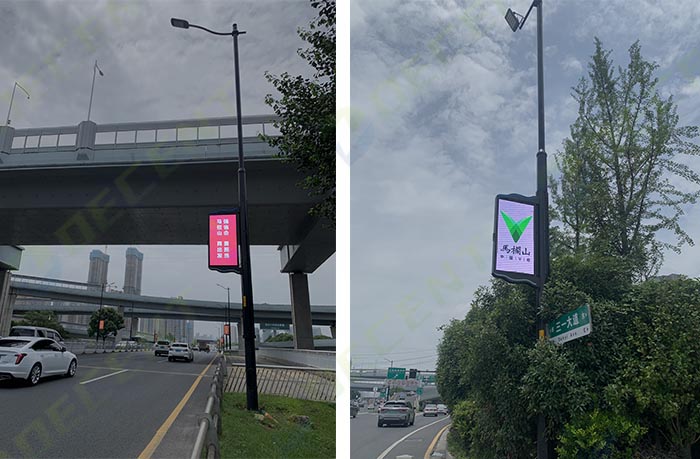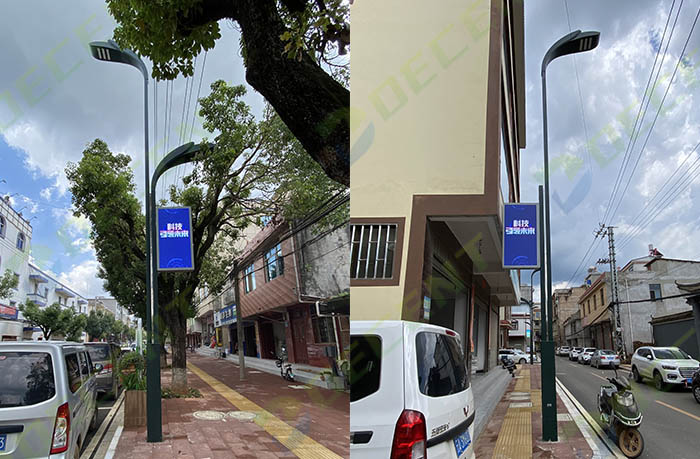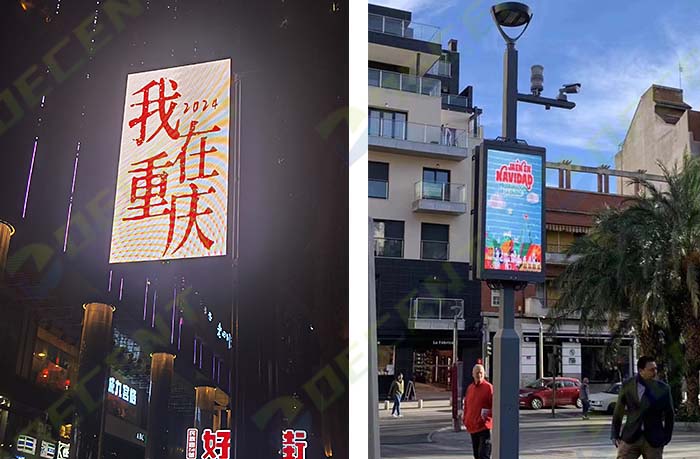



Smart light poles are revolutionizing urban infrastructure by providing a variety of functions that go beyond traditional street lighting. These intelligent structures are transforming cities into smart ecosystems, enabling better traffic management, enhancing safety, and contributing to the future of connected vehicles. In this article, we’ll explore the growing role of smart light poles in urban environments, particularly in the development of vehicle-road collaboration and smart travel.

Smart light poles are an advanced version of traditional streetlights. They combine several technologies to improve urban living. Besides providing illumination, these poles feature integrated systems like:
This combination of functions makes smart light poles a key part of smart municipal infrastructure, connecting various aspects of city management to a central network, often referred to as the “city brain.” By transmitting data from sensors and devices, smart light poles help improve urban governance and enable smarter mobility solutions.

One of the most exciting aspects of smart light poles is their role in supporting vehicle-road collaboration, particularly for autonomous vehicles. These poles are equipped with advanced sensors, including:
These sensors collect real-time traffic data, such as road conditions, traffic flow, and signal status. This information is then transmitted to connected vehicles in real time. By using this data, vehicles can make better decisions while driving, improving safety and efficiency.
For example, if a smart light pole detects a traffic jam ahead or identifies a malfunctioning traffic signal, it can alert approaching autonomous vehicles, allowing them to adjust their speed or take alternative routes. This kind of communication between infrastructure and vehicles is a crucial part of advancing autonomous driving technology.

The construction of smart light poles provides a much-needed boost to urban road perception systems. Traditional streetlights and monitoring poles often created cluttered roadways and were not optimized for the growing demands of smart infrastructure. However, with the integration of multiple devices into a single smart light pole, cities can save space and reduce the need for excessive underground infrastructure.
The multifunctional nature of smart light poles allows them to serve several purposes, all while being more aesthetically pleasing and less obtrusive. By integrating 5G base stations, cameras, and environmental sensors into one pole, cities can:
This not only improves the visual appeal of streets but also enhances the functionality of urban roads. Smart light poles help reduce road clutter and improve the perception ability of urban infrastructure by offering a unified solution that collects data from multiple sources.

As smart light poles gather vast amounts of data—such as traffic patterns, weather conditions, and environmental quality—they play a significant role in urban planning and development. The data collected is sent to the city’s central system, where it is analyzed by the “city brain.” This analysis provides actionable insights that can be used to optimize traffic management, improve road safety, and enhance the overall quality of life in urban areas.
For example, smart light poles can monitor air quality and noise levels, allowing cities to take real-time action to address environmental concerns. Additionally, the collected traffic data can assist in fine-tuning traffic lights, improving congestion management, and even predicting future traffic patterns.
These capabilities are particularly valuable as cities look to embrace vehicle-road-city collaboration. By analyzing and processing data from smart light poles, cities can make better decisions on infrastructure development, public transportation planning, and the integration of smart vehicles.

Looking forward, the role of smart light poles will only continue to grow as cities become more connected. The integration of technologies like 5G, IoT, and advanced sensors into smart light poles will enable even more sophisticated functions. As autonomous vehicles become more common, smart light poles will play an essential part in their safe and efficient operation by facilitating communication between vehicles and infrastructure.
In the coming years, smart light poles will help unlock the full potential of smart travel. They will enable more seamless vehicle-road collaboration, boost traffic management efficiency, and create safer and more sustainable urban environments. With the ongoing advancements in technology and the expansion of smart travel applications, smart light poles will light the way to the future of transportation.
Smart light poles are more than just a modern solution for urban lighting—they are a cornerstone of smart city infrastructure. By integrating multiple functions into one sleek design, these poles are helping cities improve traffic management, enhance safety, and build the foundations of the smart cities of tomorrow. As technology advances and the demand for smarter urban solutions grows, smart light poles will continue to play a pivotal role in the coordinated development of vehicles, roads, and cities, paving the way for smarter travel and a brighter future.
By embracing the capabilities of smart light poles, cities can look forward to a future of safer, more efficient, and sustainable transportation.
contact us
Stay up-to-date with our new product releases and latest news articles. DECENT Technology is a leading global supplier of LED display screens, providing customers worldwide with comprehensive solutions for the research and development, manufacturing, engineering installation, and after-sales service of high-end LED display equipment and display control systems. At present, it has developed into a national high-tech enterprise with over 1300 employees and more than 400 authorized national patents. The company has successively obtained safety production license, steel structure construction qualification, system integration qualification, third level professional contracting for building mechanical and electrical installation engineering, and second level professional contracting for electronic and intelligent engineering.
DECENT Technology is positioned as "core technology oriented" and has deeply cultivated and worked in the LED industry. It has established numerous marketing centers, offices, and after-sales service outlets worldwide. The company's products are distributed in more than 200 countries and regions, and has accumulated over 40000 classic cases. The strong comprehensive strength has made DECENT Technology the preferred brand among the Fortune Global 500 companies such as Sinopec, PetroChina, Tencent, Alibaba, Huawei, and Abbott.
Since its establishment, DECENT Technology has accumulated 10 industry-leading technologies and 43 innovative "black technology" technologies; And we have developed six product lines, including professional display, universal display, conference display, commercial display, outdoor led display, and rental display, which are applied in multiple scenarios such as command and monitoring, commercial display retail, broadcasting and broadcasting, outdoor advertising, sports events, and stage performances. The product quality maintains a leading position in the industry.
In the future, DECENT Technology will continue to adhere to the business philosophy of "product+service" and the corporate values of "innovation, sunshine, struggle, and gratitude", continuously moving towards higher technology, better services, and harder quality, committed to providing professional LED display system solutions for every customer.
DECENT Technology is a leading global supplier of LED display screens, providing customers worldwide with comprehensive solutions for the research and development, manufacturing, engineering installation, and after-sales service of high-end LED display equipment and display control systems. At present, it has developed into a national high-tech enterprise with over 1300 employees and more than 400 authorized national patents. The company has successively obtained safety production license, steel structure construction qualification, system integration qualification, third level professional contracting for building mechanical and electrical installation engineering, and second level professional contracting for electronic and intelligent engineering.
DECENT Technology is positioned as "core technology oriented" and has deeply cultivated and worked in the LED industry. It has established numerous marketing centers, offices, and after-sales service outlets worldwide. The company's products are distributed in more than 200 countries and regions, and has accumulated over 40000 classic cases. The strong comprehensive strength has made DECENT Technology the preferred brand among the Fortune Global 500 companies such as Sinopec, PetroChina, Tencent, Alibaba, Huawei, and Abbott.
Since its establishment, DECENT Technology has accumulated 10 industry-leading technologies and 43 innovative "black technology" technologies; And we have developed six product lines, including professional display, universal display, conference display, commercial display, outdoor led display, and rental display, which are applied in multiple scenarios such as command and monitoring, commercial display retail, broadcasting and broadcasting, outdoor advertising, sports events, and stage performances. The product quality maintains a leading position in the industry.
In the future, DECENT Technology will continue to adhere to the business philosophy of "product+service" and the corporate values of "innovation, sunshine, struggle, and gratitude", continuously moving towards higher technology, better services, and harder quality, committed to providing professional LED display system solutions for every customer. Do you have any questions or requests?
Click below, we are happy to provide assistance. contact us